| THIS WEEK'S ARTICLES |
| The Market Message |
| A Longer Term Look at Freeport McMoran Shows a New Bull Trend |
| by John Murphy |
This article is about using charts in different time spans to gain a better perspective on an individual stock or any other market. I'm using copper producer Freeport McMoran (FCX) to make that point. I'm picking that stock because it's Wednesday's biggest percentage gainer in the S&P 500 and has already had a strong run. Previous messages have shown the price of copper rising to the highest level in seven years which has been the main driver behind FCX and other copper producers. So this isn't new story. The question here is whether the stock is too high to buy; or whether there's more upside to come. The daily bars in Chart 1 show the stock rising to a new 52-week high which makes it look pretty expensive. Its weekly chart offers a better perspective.
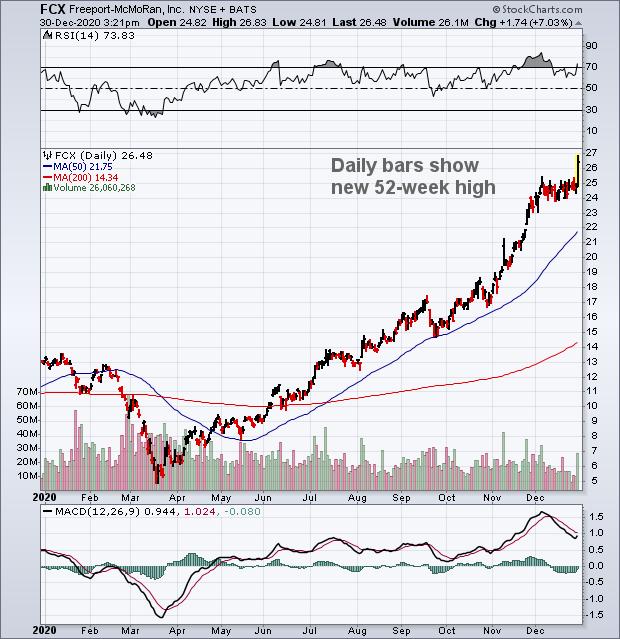 Chart 1 Chart 1
The weekly bars in Chart 2 paint a more bullish picture for Freeport McMoran. It shows the stock rising above its early 2018 peak near 19.00 to complete a major bottom. And suggests that the stock has more upside to come. Measuring the height of the bottoming pattern from peak to trough (19 - 3) and adding that to the breakout point near 19 suggests that FCX has the potential of eventually reaching its 2014 high near 36. Its weekly RSI line is in overbought territory which may slow the advance temporarily. But the chart suggests that FCX is in the early stages of a new bull run. Its monthly chart also appears to support higher prices.
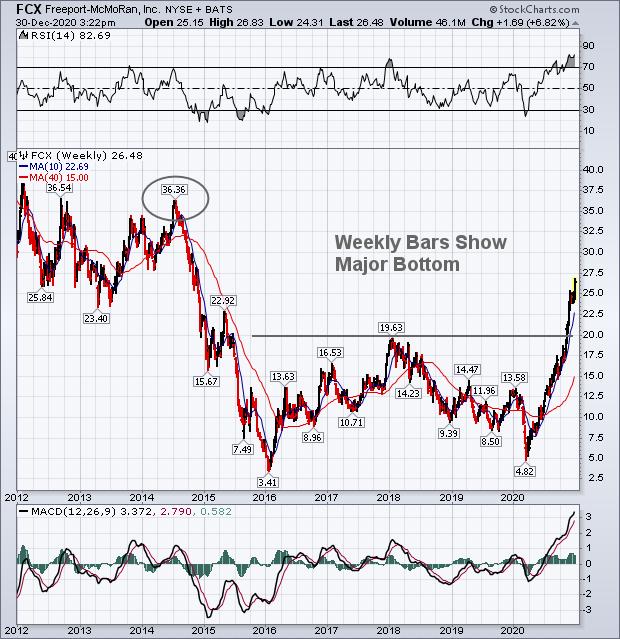 Chart 2 Chart 2
Monthly charts spanning a decade or more usually provide the best perspective on any chart. And that may be the case here. The monthly bars in Chart 3 show the bullish breakout in FCX in better perspective. Not only has the stock risen to a six-year high to complete a major bottom; a major down trendline extending back to 2011 has been exceeded. The chart shows the next potential upside target near 36 more clearly. It also shows the stock peaking twice near 48 during 2008 and 2011. This longer range perspective suggests that the copper producer is still in the early stages of a new bull trend, and probably has a lot further to run.
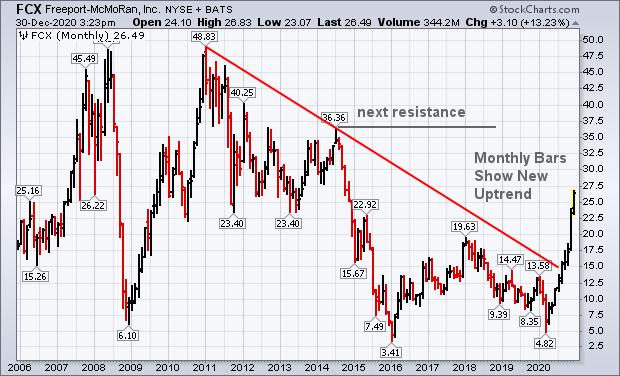 Chart 3 Chart 3
Editor's Note: This is an article that was originally published in John Murphy's Market Message on Wednesday, December 30th at 2:56pm ET.
|
| READ ONLINE → |
|
|
|
|
|
| Trading Places |
| 5 Things to Know About This Secular Bull Market |
| by Tom Bowley |
Happy New Year!
Many market pundits view every year in the stock market exactly the same. I do not. I believe there are "big picture" headwinds and tailwinds that impact the stock market in much the same way as currents impact fish attempting to swim upstream vs. downstream. Or maybe consider the effect that the jet stream has on a plane traveling east to west vs. west to east. A fish swims faster downstream. A plane travels faster west to east (in the U.S.).
The stock market performs stronger in a secular bull market given the exact same fundamentals. It's just the way it works.
As we move into a brand new year, I want you to think about 5 things as they relate to this secular bull market that we're enjoying:
Bird's Eye View
Sometimes, when you're in the midst of something, you don't truly understand the significance of it. But when you step back and look later, it all becomes much clearer. Well, I believe we're in the midst of one of the best secular bull markets of our lifetime. When you deal day-after-day with a trade war, and then a 100-year pandemic, it's very easy to become easily distracted and lose sight of the big picture. I want you to re-focus on the big picture:
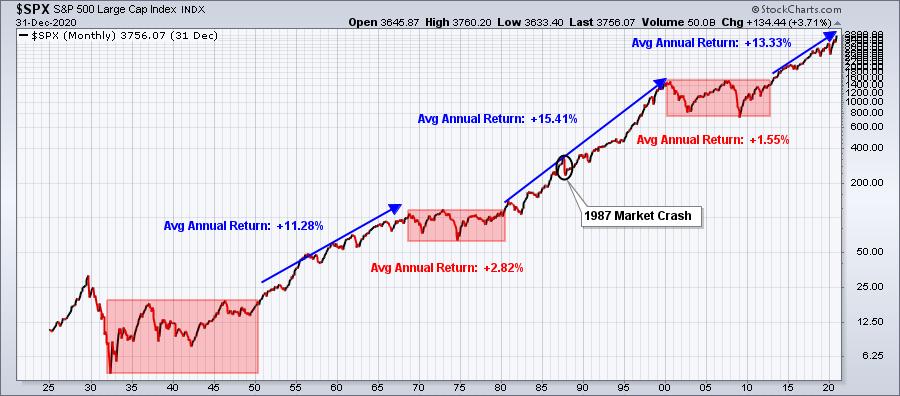
History repeats itself, and we're currently in the midst of another strong secular bull market advance. We swept the trade war and pandemic to the side just like the 1980s-1990s secular bull market scoffed at the 1987 market crash. Based on the above chart, I believe the current secular bull market will continue throughout this decade, at a minimum. You can fight it or join it.
The Biggest Advances Occur in the Month of Earnings
I've broken down the last decade's rally into 3 "baskets", if you will. First, there's the month of earnings or "Month 1" (January, April, July, and October). Then there's "Month 2" (February, May, August, and November). Finally, there's "Month 3" (March, June, September, and December). Want to see a breakdown of how the S&P 500 has performed among these 3 months?
- "Month 1": +7.4%
- "Month 2": +3.8%
- "Month 3": +0.5%
After seeing the above numbers, I hope you're a believer that Wall Street accumulates stocks as earnings season approaches. If not, you might consider the following annualized returns for the S&P 500 throughout the past decade:
- December 28th - January 18th: +35.16%
- March 28th - April 18th: +35.43%
- June 28th - July 18th: +63.71%
- September 28th - October 18th: +19.15%
Do you believe me now?
Aggressive Sectors Lead
Anyone who follows my work knows I despise diversification. That's the media "teaching" us how to invest, which is laughable. When you're in a secular bull market, there's one thing holding back your performance. It's diversification.
Warren Buffett, arguably the best investor of all-time, summed it up best when he said, "diversification is a protection against ignorance." He went on to say, "it makes very little sense for those who know what they're doing." During secular bull markets, invest primarily in aggressive sectors and maximize your returns and financial security. On April 10, 2013, the S&P 500 finally cleared the prior highs set in 2000 and 2007. That's really what triggered the current secular bull market. Let me summarize for you the cumulative returns of our 11 sectors from that date through December 31, 2020, compared to the "widely diversified" benchmark S&P 500:
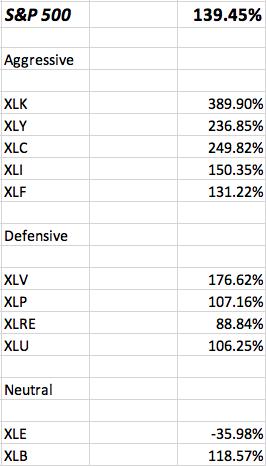
How might you have done if the majority of your investments had been in those 5 aggressive sectors? If you want the one real key to how we significantly outperform the S&P 500 with our portfolios at EarningsBeats.com, the above breakdown is it. We invest in what's working and ignore what's not. Why throw your money down a rat hole?
Weighting your investments appropriately is extremely important during these bull markets. We have both stock and ETF portfolios at EarningsBeats, with nearly every one significantly outperforming the benchmark S&P 500. Some might look at our numbers and think it's impossible. It's not. Unfortunately, we're "trained" by the media to buy into the diversification theory, which only hinders our returns. Change the way you think. Invest in what's working and based on where we are in the stock market cycle. During a secular bull market, concentrate your investments or trades in the aggressive sectors. Leave the underperformance to those wanting to benefit from "diversification."
Stay the Course
We've all heard it before. "We can't go any higher." Or "but we've gone up so much already." Or maybe it's "What about our pile of national debt?" or "the house of cards will come tumbling down next year!"
Consider these facts:
- The S&P 500 has risen 52 of 71 (73.2%) years since the start of 1950
- The S&P 500 has risen 38 of 48 (79.2%) "secular bull market" years since the start of 1950
- The S&P 500 has risen 14 of 23 (60.9%) "secular bear market" years since the start of 1950
While there are absolutely times that we want to be more cautious, I will never understand the determination of the many market participants on the "dark side," who consistently bet against U.S. stocks. Those numbers do not lie. They are factual and should convince you to remain primarily bullish.
Technicals Rule
In March, we kept hearing about the coming Great Depression 2.0. It makes for scary headlines and is excellent click bait, but the charts never suggested such a calamity was about to unfold. It's always scary to see your portfolio plunging, but it's also very important to look objectively at what's occurring. Don't listen to those who do not have your personal financial interest in mind. This includes the hype-driven media outlets, who only care about you clicking on their articles, driving up clicks and revenues.
I wrote an article back on April 10th in ChartWatchers that you should go back and read. I'm not writing this article telling you anything in hindsight. My articles are archived here and the one I wrote on April 10th was in real-time, in the midst of this once-in-a-lifetime pandemic. The article was titled, "This is How I Created My All-Star Trading ChartList". It marked the beginning of switching to the Accumulation/Distribution (AD) line as a primary technical indicator. Markets change and we MUST change with them. What worked last week, or last month or last year (or even last bull or bear market) likely won't work again. We must stay on our toes and continue to analyze. We need to look "beneath the surface" of the market to assess what's truly transpiring. This period and analysis led to our Strong AD Portfolio, which was initiated on May 19th and has gained 74.48% in the last 6 1/2 months, comparing quite favorably to the S&P 500's return of 28.50% over the same period.
I will continue to work tirelessly for our StockCharts.com and EarningsBeats.com communities. On Monday, I plan to provide our EB Digest (free newsletter) community a heatmap showing the groups that have been benefiting the most from January seasonality trends throughout the current secular bull market. If you'd like to receive this information, simply CLICK HERE to register. Registration does not require a credit card and you may unsubscribe at any time.
Let's hope that 2021 brings everyone hope, better health and more financial freedom!
Tom
|
| READ ONLINE → |
|
|
|
| The Traders Journal |
| Insights, Lessons Learned And Skills Reinforced From 11 Market Wizards In 2020 |
| by Gatis Roze |
 The catalyst for this blog is the new Stock Market Wizards book that happily appeared under my Christmas tree last week. When I opened this gift, I was in the midst of doing my own annual page-by-page review of my personal Traders Journal for the year 2020. Putting that aside, I eagerly read through Jack Schwager's newest book, Unknown Market Wizards (2020, Harriman House). The catalyst for this blog is the new Stock Market Wizards book that happily appeared under my Christmas tree last week. When I opened this gift, I was in the midst of doing my own annual page-by-page review of my personal Traders Journal for the year 2020. Putting that aside, I eagerly read through Jack Schwager's newest book, Unknown Market Wizards (2020, Harriman House).
This particular Schwager book with his interviews of 11 investors / traders related to me on a very personal level. Why so? The mere fact is that unlike his other Market Wizards books — with billionaire traders like Paul Tudor Jones, Richard Dennis and Bruce Kovner — the real world traders in this new book are a lot more like me. In that light, for page after page, trader after trader, a recurring truth resurfaces consistently. It's one that we investors need to hear and reinforce — you must "keep a Trader's Journal." For example, Richard Bargh records his thoughts and feelings daily to identify weaknesses in his mindset. He does this to keep track of how his mindset changes over time. Another trader talks about how his journal helps him highlight trading errors. It's clear to him that you must learn from your mistakes and embrace the lessons if you are to become a consistently profitable long-term investor.
Trader Daljit Dhaliwal talks about the importance of a methodology that fits one's own personality. Your personal Traders Journal is the tool to make that a reality. Another trader explains the importance of risk management to one's success. The strange phenomenon with investors is that one's risk tolerance shifts constantly so a personal journal is the best way to gauge these shifts over time and to invest accordingly to reflect your personal risk over time. Nearly all of these wizards talk about having a precise methodology. A shoot-from-the-hip approach is the antithesis of successful investing. In reality, we've all been guilty of such impulsive behavior. Therefore, our journals become our confessionals, helping us avoid the dark side of trading outside of our methodology.
Speaking metaphorically, there is an interesting two-headed dragon that appears as one reads this book. One head of the beast advocates for taking larger positions on select high-conviction trades which is a well-documented strategy of most exceptional traders. The other dragon head, however, is overly fearful of large trades and becomes paralyzed into a mindset that clearly leads to poor decisions. The best therapy for reconciling this two-headed creature is your trading journal. Addressing this balance and writing about it in your journal leads to better outcomes that will improve your bottom line.
Another theme which emerges is that investors must never underestimate the importance of acknowledging and dealing with their own human nature. This particular theme is also a big part of our book, Tensile Trading. We call it the "Investor Self". Schwager's wizards tell stories of being adversely impacted by their own emotion-based actions. In particular, they contend that trades motivated by greed or by a compulsion to make back money lost in the same market causes serious damage to both present and future trades. Short of a therapist or personal trading coach, their trading journals proved to be the best device available to identify and corral these killer tendencies.
I especially related to one of the Wizards who describes how he lightens up his positions amidst the euphoria of a parabolic market move — always wanting to be on the right side of a liquidation panic while accepting the actuality that he'll leave some money on the table. My own 2020 trading journal has a provocative narrative of my struggles this year with precisely this situation. Writing about my present conflicts real time and chronicling my thinking and behaviors has had the effect of vaccinating me against future missteps. If you don't have routines which embrace lessons learned, then those insights will be wasted and mistakes will recur. You'll be destined once again to pay tuition to the University of Wall Street!
A number of the Wizards disclose the need to spot emerging trends in both social media and happenings of everyday life as a source of uncovering trading opportunities. They maintain that similar reappearing observations in your trading journal will alert you to these progressions and allow you to profit from your vision.
Finally, I felt an affiliation to Amrit Sall as he speaks about what he calls the "Internal Game of Trading". He contends that keeping a trading journal helps him maintain focus with a calm mindset. Moreover, he talks about charting the connection between emotions and losses. Purging self-sabotaging behavior preserves his "mental capital" which he claims is a critical aspect of trading success. Others touch as well upon these very same sentiments.
In closing, let me paraphrase a quote by Musauer Mansoor Ijaz: "There is no such thing as beating the market. When you make money, it is because you understood the same thing as the market did and you behaved in the appropriate manner. If you lose money, it's simply because you refused to listen to the market and behaved inappropriately. There is no other way of looking at it."
My advice remains the same as always, Keep a trading journal in order to better understand your behavior and to help you hear what the market is saying.
Trade well; trade with discipline!
- Gatis Roze, MBA, CMT
StockMarketMastery.com
|
| READ ONLINE → |
|
|
|
| RRG Charts |
| Financials En-Route For a Strong Start in 2021 |
| by Julius de Kempenaer |

My first article for the Chartwatchers newsletter going into the new year... 2021!!
First of all, I wish all readers and watchers of Sector Spotlight a very happy and, above all, healthy new year. That "Healthy" part all of a sudden has gotten a whole new meaning after 2020, in the sense that it is more serious than ever before.
Let's kick off 2021 with a look at the Relative Rotation Graph for US sectors and the Financials sector in particular.
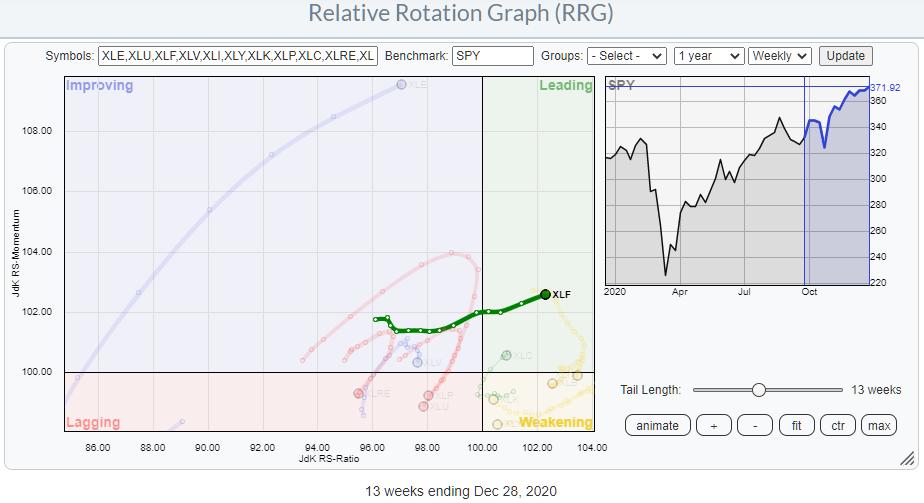
The tail on XLF shows a stable move towards the right, more positive, side of the RRG. And, together with XLC (Communications Services), it is one of the only two sectors inside the leading quadrant; both are rotating at a strong RRG-Heading.
The RS-Momentum level has been fairly stable over the last 13 weeks, causing an almost straight tail. The pickup in relative momentum, in combination with the increasing RRG-Velocity (distance between the weekly observations), makes Financials a very interesting sector to keep an eye on while going into the new year.
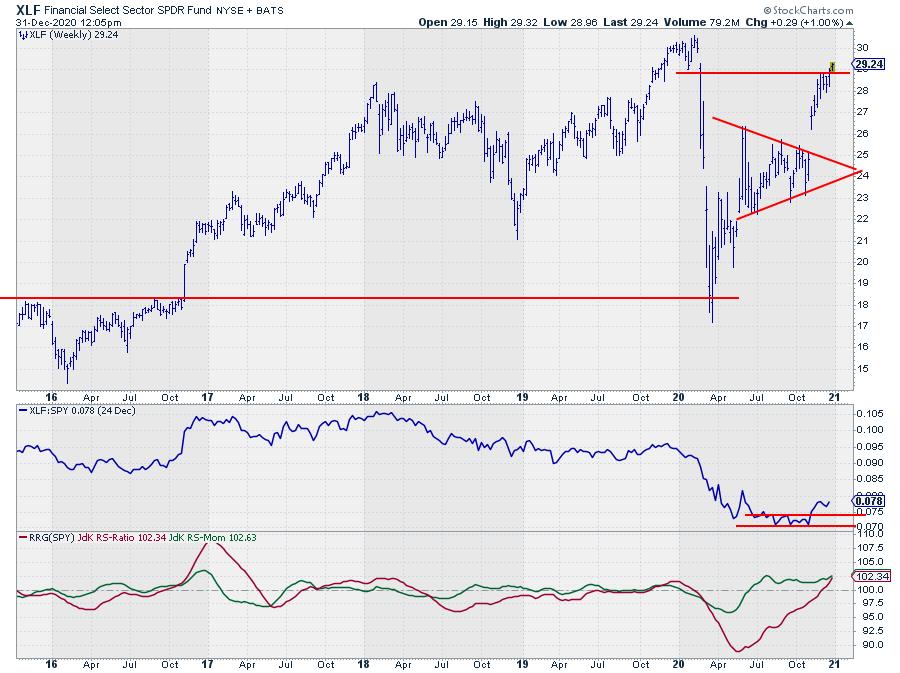
After breaking away from the consolidation triangle that was formed from May to October, XLF stalled against resistance just below $29. This week, XLF looks to be taking out that resistance level, which frees the way towards the February high at $30.60.
What is more important is that the relative strength line managed to hold up above its breakout level and seems to be putting in a new, higher, low, confirming that the early stages of a new relative uptrend are taking shape.
Zooming in on Individual Stocks
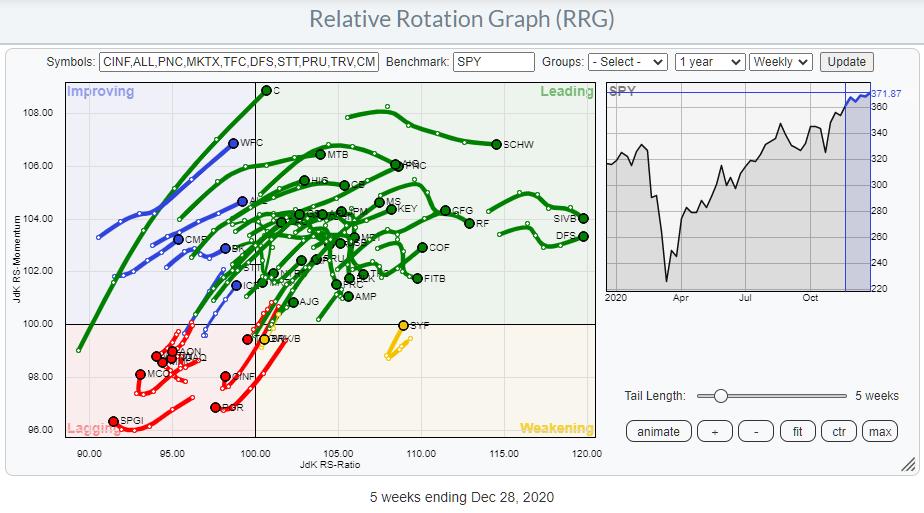
The RRG above shows the individual stocks inside the financials sector against SPY as the benchmark. The clear shift, with the majority of Financial stocks inside the leading quadrant, confirms the underlying strength for the sector.
Takeaway... The stocks that are inside the lagging quadrant against SPY are CERTAINLY inside the lagging quadrant against XLF and are the weakest in the sector!
You can also see that a few stocks have already travelled to (very) high JdK RS-Ratio levels. These are the strong(est) stocks for the moment. But the odds for them to travel even further are getting lower. Or, in other words, the risk/reward ratio is getting higher and potentially less interesting.
So, for possible new candidates that could emerge as new leaders for the sector going into the new year, I run the RRG for these Financial stocks against XLF.
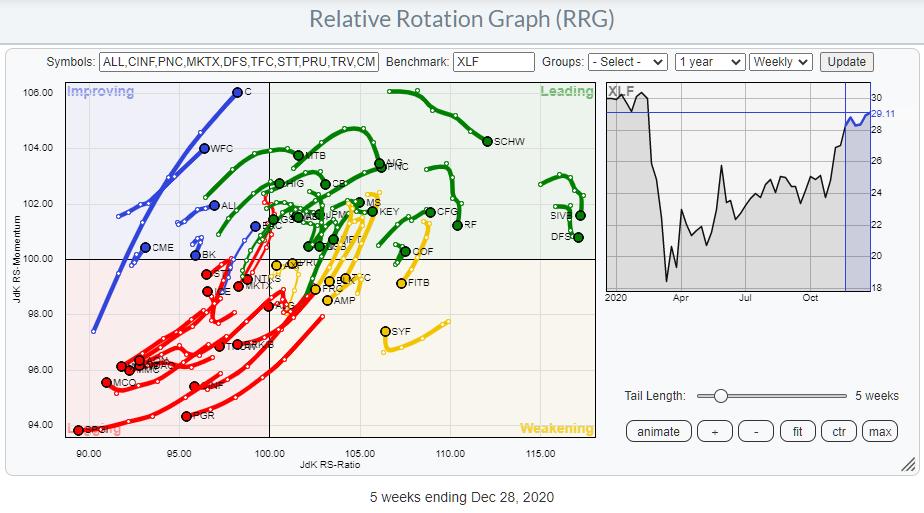
Here you see a more evenly spread out universe around the benchmark, which is to be expected as this is a so called "closed-universe" where all members of the benchmark are plotted on the chart.
As we already know that XLF is at a strong rotational heading and inside the leading quadrant, I want to focus on stocks that are either inside the improving quadrant and traveling towards leading at a strong heading or stocks inside the weakening quadrant that are curling up and started rotating back up to the leading quadrant.
The next RRG below, shows the most (imho) interesting stocks that seem to be setting up to become new leaders inside the financial sector.
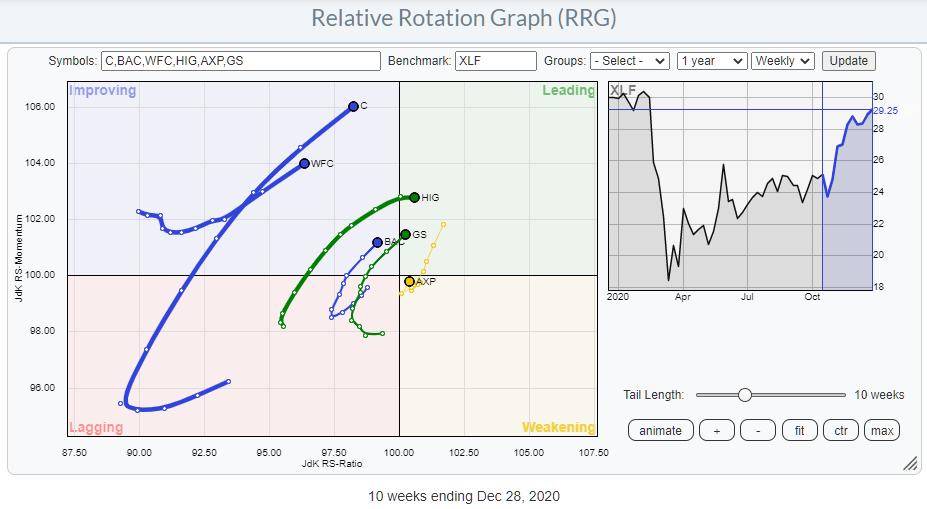
I have isolated 6 names on the chart above and what I found interesting to see is that the three stocks inside the improving quadrant are all banks, which makes that group even more interesting to watch in the next few weeks.
After studying all three of these banks inside the improving quadrant (C, WFC, BAC), I think BAC is showing the most promising chart.
Bank of America - BAC

BAC already broke above resistance around $28 a few weeks ago, then hesitated a few weeks while managing to hold up above the breakout level. It is now starting to move away upwardly.
This makes it a pretty reliable breakout with solid support around $28, while the previous high just below $35 can be seen as the next target, with some intermediate resistance around $32 on the way up.
The turnaround in relative strength makes BAC a potential candidate to become a new leader in this sector. In general, 2020 was characterized as a relative downtrend for BAC against XLF - at least in the first six months. After bottoming in July, the RS-line held up above that low in its subsequent down-leg, which bottomed in the same area.
The move higher off of that support area is now breaking the falling resistance line, which is a first sign for improvement.
Combined with the improvement and the break in the price chart, this sets up BAC for a good start in the new year!!

Here's a toast to a Happy, and much better, New Year. Hope to see you all back as readers of the RRG blog and watchers of Sector Spotlight. As usual, please stay in touch!!
My regular blog is the RRG Charts blog. If you would like to receive a notification when a new article is published there, simply "Subscribe" with your email address.
|
| READ ONLINE → |
|
|
|
| The MEM Edge |
| These Recovery Plays Are In Strong Buy Zones |
| by Mary Ellen McGonagle |
Happy New Year!
The S&P 500 closed the year at a new high in price despite record new COVID-19 cases worldwide. A new, more contagious variant of the virus is also being ignored as investors are instead focused on an economic recovery buoyed by the rollout of vaccines.
Last year, Growth stocks led the way, with the Tech-heavy Nasdaq gaining 43.7%, driven higher by outsized returns in Software and Semiconductor companies that kept locked-down employees and students connected. Subscribers to my MEM Edge Report experienced triple-digit gains as high as 203% among Growth stocks that were highlighted on our Suggested Holdings List.
While many of last year's winners are expected to continue to trade higher, there's been a shift in the near-term toward recovery stocks that will benefit as the economy emerges from coronavirus restrictions.
Let's take a look at global payment processor Visa (V), which was among the major credit card companies that saw double-digit drops in profit for their 3rd quarter. These companies derive a large portion of their revenues from cross-border payments, and travel restrictions put a big dent in their growth.
DAILY CHART OF VISA, INC. (V)
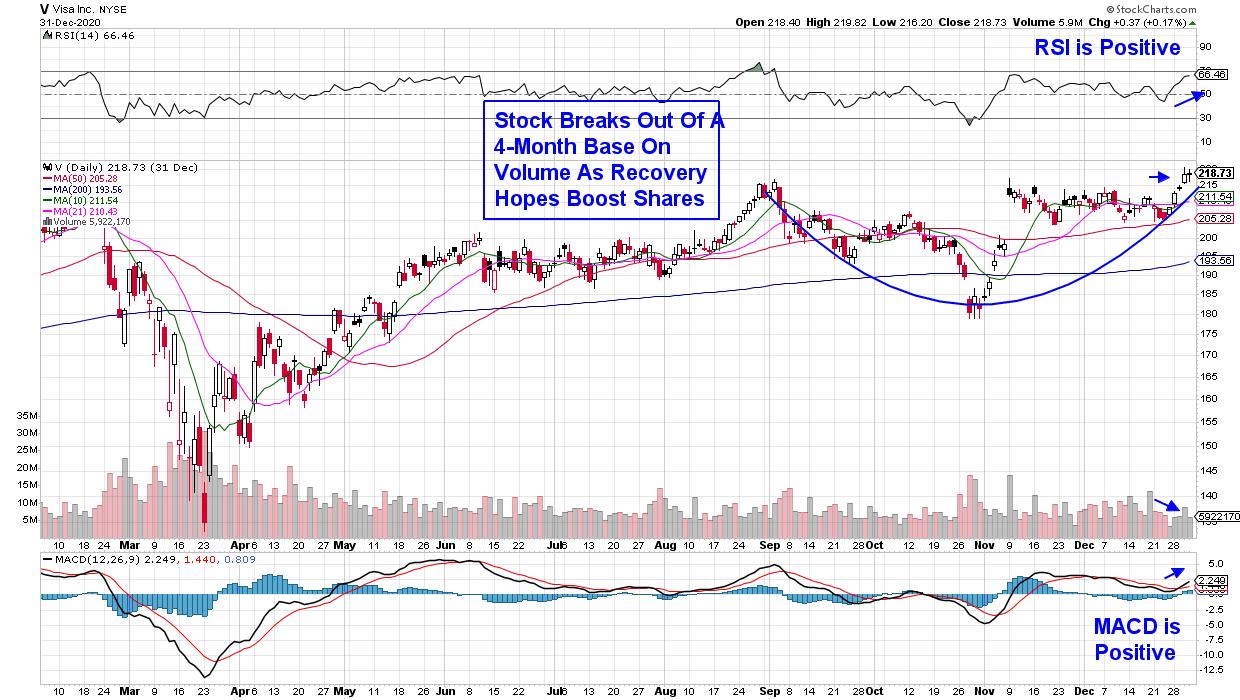
Visa (V) is now in a strong buy zone following last week's 4-month base breakout on volume. Not only do the prospects of a pickup in travel have analysts raising estimates, but Visa is the first credit card to offer Bitcoin rewards rather than airline miles. The company rolled this feature out last month and the move has already increased adoption of the card.
Bank stocks are also springing back to life as loan default fears amid historical levels of unemployment have receded. The group also received a boost last month from the Federal Reserve's decision to allow share buybacks among the largest Banks.
DAILY CHART OF COMERICA, INC. (CMA)
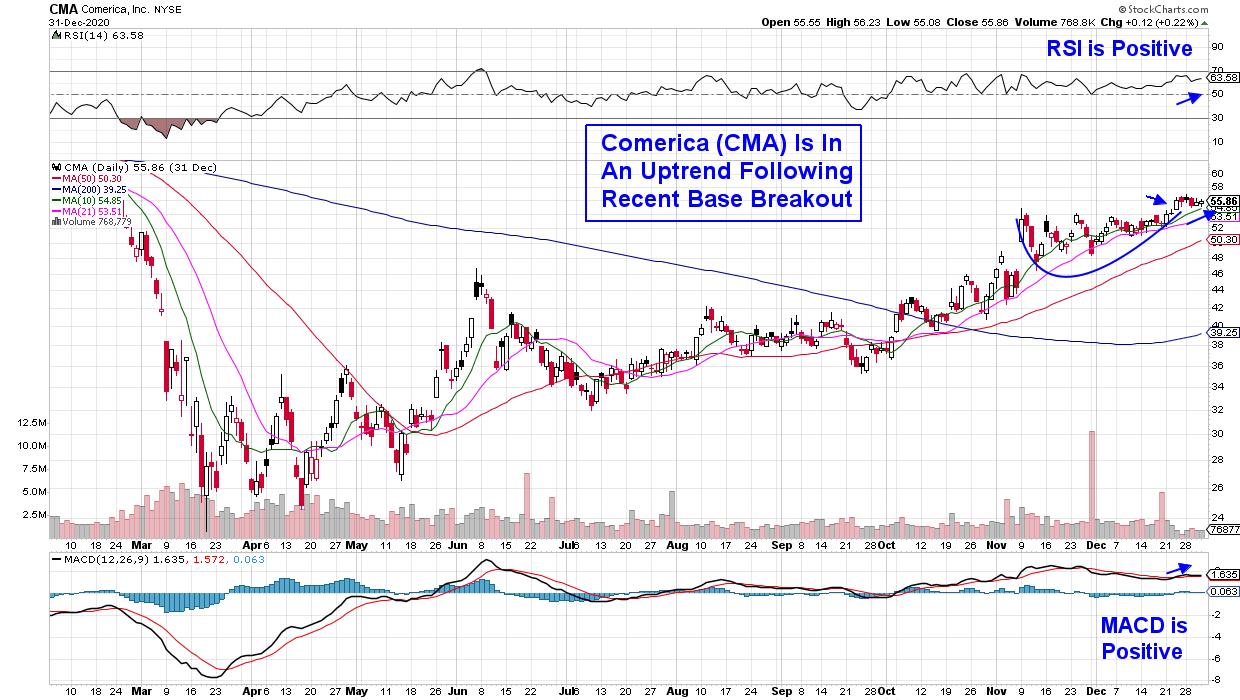
The Fed's action confirms the strong balance sheets and growth prospects going forward for Banks such as Comerica (CMA), which has estimates for a 38% pickup in earnings in 2021 over last year. This 4.9% yielder recently broke out of a 7-week base and is poised to trade higher.
And with travel restrictions expected to be lifted over time, Hotel and Lodging stocks are also getting a boost, with names such as Hilton Worldwide (HLT) poised to break out of 7-week base. A breakout at the $117 level would be very bullish for the stock.
DAILY CHART OF HILTON WORLDWIDE HOLDINGS, INC. (HLT)

The global hotelier responded quickly to unprecedented challenges that were brought on by the pandemic with contactless guest experiences and industry-setting cleaning standards, all while continuing to open new locations around the world. Analysts are calling for 713% growth in earnings in 2021 from depressed levels last year.
In addition to recovery stocks joining already-strong Growth stocks, I'm anticipating renewed interest in Cyclical stocks as the new year takes shape. Subscribers to my MEM Edge Report were alerted to Cyclical bank stock Comerica (CMA) in late October, and the stock has since outpaced the S&P 500 by 40%.
If you'd like to be alerted to when a more pronounced shift into Cyclical stocks takes place, as well as which names will benefit the most, take a 4-week trial of my MEM Edge Report for a nominal fee. You can check out some of our recent picks, as well as a sample of this detailed, bi-weekly report by using the above link as well.
And to all those who already subscribe to the top performing MEM Edge Report, thank you! Here's to 2021 being our best year yet.
Warm Regards,
Mary Ellen McGonagle, MEM Investment Research
|
| READ ONLINE → |
|
|
|
|
|
| MORE ARTICLES → |
|
 Chart 1
Chart 1 Chart 2
Chart 2 Chart 3
Chart 3





 The catalyst for this blog is the new Stock Market Wizards book that happily appeared under my Christmas tree last week. When I opened this gift, I was in the midst of doing my own annual page-by-page review of my personal Traders Journal for the year 2020. Putting that aside, I eagerly read through Jack Schwager's newest book,
The catalyst for this blog is the new Stock Market Wizards book that happily appeared under my Christmas tree last week. When I opened this gift, I was in the midst of doing my own annual page-by-page review of my personal Traders Journal for the year 2020. Putting that aside, I eagerly read through Jack Schwager's newest book, 































